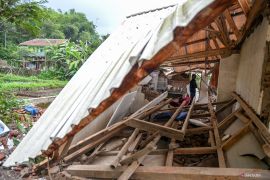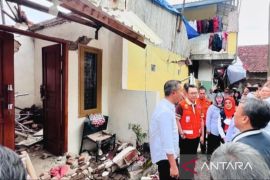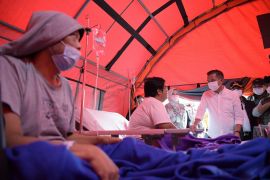In general, structures of the buildings still look good, but we find several cracks. Therefore, we need to retrofit and beautify the buildingsJakarta (ANTARA) - Indonesia's Public Works and Housing Minister Basuki Hadimuljono stated that his ministry would prioritize the repair of Sumedang Public Hospital and SMAN 1 school buildings in the aftermath of a series of recent shallow earthquakes.
"In general, structures of the buildings still look good, but we find several cracks. Therefore, we need to retrofit and beautify the buildings," he told journalists in Jakarta on Wednesday.
Hadimuljono noted that the building repair would start next week, as the Sumedang Public Hospital's operating and dialysis rooms had to be repaired immediately.
The shallow quakes, with the highest magnitude of 4.8 that struck Sumedang District, West Java Province, on Sunday evening, also damaged at least 1,100 houses, he stated.
Regarding the reported number of damaged houses, Hadimuljono remarked that a joint team of personnel from his ministry and the National Disaster Mitigation Agency (BNPB) are verifying the reported damages.
The minister stated that the government's assistance will be provided for damaged residential buildings based on their degrees of damage.
Related news: Banten's M5.9 earthquake damages 10 houses in Sukabumi: BPBD
Regarding the post-earthquake condition of several strategic infrastructure facilities, including the Cisumdawu Toll Road, Cipanas Dam, Sadawarna Dam, and Jatigede Reservoir, Hadimuljono said his side had checked them.
The minister revealed that the assessment results showed that there were no damages to infrastructure facilities, and they have been declared "safe."
The epicenter of the shallow earthquake, with the highest magnitude of 4.8 that struck Sumedang on Sunday evening, was located at a depth of five kilometers.
The Meteorology, Climatology, and Geophysics Agency (BMKG) reported two aftershocks following the quake. The aftershocks did not cause any damage.
According to head of the agency's Earthquake and Tsunami Center, Daryono, the 4.8-magnitude quake was a "shallow crustal earthquake" that was triggered by the movement of an active fault in the area.
The Sumedang earthquake may be associated with the Cileunyi-Tanjungsari fault, he added.
Related news: 5.9M quake in W Java caused by rock deformation: expert
In the past, an earthquake of magnitude 4.5 had jolted Sumedang District on December 19, 1972. The shallow quake damaged several houses and triggered a landslide in the Cibunar neighborhood area, Daryono stated.
The Sumedang quake caused damage to buildings, as its epicenter was located at a depth of five kilometers, he explained.
Earthquakes regularly rock several parts of Indonesia since the country lies on the Circum-Pacific Belt, also known as the Ring of Fire, where several tectonic plates meet and cause frequent volcanic and seismic activities.
On December 26, 2004, Aceh, the country's westernmost province, experienced the deadliest earthquake ever on record. The quake had a magnitude of 9.3 and was followed by a tsunami.
The catastrophe, which also affected certain coastal areas in countries, such as Thailand, Sri Lanka, and India, reportedly killed at least 230 thousand people in Aceh.
Related news: Ministry sends logistics aid to quake-affected people in Sumedang
Translator: Aji C, Rahmad Nasution
Editor: Jafar M Sidik
Copyright © ANTARA 2024












